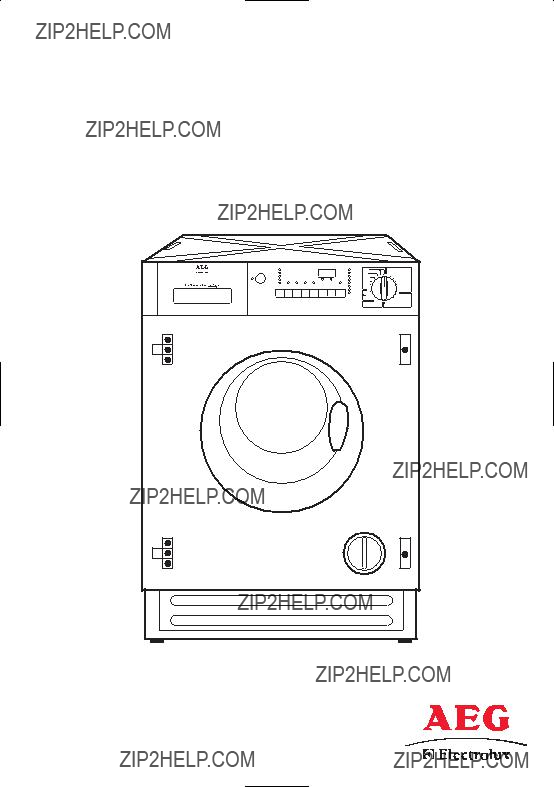
LAVAMAT TURBO 12710 VIT LAVAMAT TURBO 14710 VIT
Instruction Booklet
PERFEKT IN FORM UND FUNKTION

LAVAMAT TURBO 12710 VIT LAVAMAT TURBO 14710 VIT
Instruction Booklet
PERFEKT IN FORM UND FUNKTION

Dear customer,
Please read these operating instructions carefully and pay particular atten- tion to the safety notes indicated in the first pages. We recommend that you keep this instruction booklet for future reference and pass it on to any future owners.
The warning triangle and/or the key words (Warning!, Caution!) emphasize information that is particularly important for your safety or correct func- tioning of the appliance.
This symbol guides you, step by step, in the operation of the appliance.
The information marked with this symbol provides additional instructions and practical tips on the use of the appliance.
Tips and information about economical and ecological use of the machine are marked with the clover symbol.
If you require assistance or advice on your appliance, please contact our cus- tomer care department by letter or telephone:
Customer Care Department
AEG/ELECTROLUX Major Appliances
Addington Way
Luton
Bedfordshire LU4 9QQ
Tel: 08705 350 350*
*calls to this number may be recorded for training purposes.
Important
Your machine is fitted with a balance control device, which ensures the
If the wash load appears not to have been spun sufficiently at the end of the wash cycle, because it is not evenly distributed in the drum, the balance control device may have operated. It will therefore be necessary to redistribute the wash load man- ually and select a spin programme. For more detailed information see the section headed "Something Not Working".
Printed on recycled paper.
People who think ecologically, act accordingly....
2

Main features of your
Description of the appliance . . . . . . . . . . . . . . . . . . . . . . . . . . . . . . . . . . . . . . . . . . . . . . 11 Control panel. . . . . . . . . . . . . . . . . . . . . . . . . . . . . . . . . . . . . . . . . . . . . . . . . . . . . . . . . . . . . 12 Programme selector dial. . . . . . . . . . . . . . . . . . . . . . . . . . . . . . . . . . . . . . . . . . . . . . . . 12 ON/OFF button . . . . . . . . . . . . . . . . . . . . . . . . . . . . . . . . . . . . . . . . . . . . . . . . . . . . . . . . 13
Before the first wash. . . . . . . . . . . . . . . . . . . . . . . . . . . . . . . . . . . . . . . . . . . . . . . . . . . . . 18
3

Contents
And in which form?. . . . . . . . . . . . . . . . . . . . . . . . . . . . . . . . . . . . . . . . . . . . . . . . . . . . . . . 23 TRADITIONAL POWDERS. . . . . . . . . . . . . . . . . . . . . . . . . . . . . . . . . . . . . . . . . . . . . . . . 23 TRADITIONAL LIQUIDS. . . . . . . . . . . . . . . . . . . . . . . . . . . . . . . . . . . . . . . . . . . . . . . . . . 23 COMPACT POWDERS AND LIQUIDS. . . . . . . . . . . . . . . . . . . . . . . . . . . . . . . . . . . . . . 23 FABRIC CONDITIONERS. . . . . . . . . . . . . . . . . . . . . . . . . . . . . . . . . . . . . . . . . . . . . . . . . 23
Preparing the drying cycle. . . . . . . . . . . . . . . . . . . . . . . . . . . . . . . . . . . . . . . . . . . . . . . . 24 Load. . . . . . . . . . . . . . . . . . . . . . . . . . . . . . . . . . . . . . . . . . . . . . . . . . . . . . . . . . . . . . . . . . . . . 24 Garments not suitable for drying . . . . . . . . . . . . . . . . . . . . . . . . . . . . . . . . . . . . . . . . . . . 24 Drying symbols on garment labels . . . . . . . . . . . . . . . . . . . . . . . . . . . . . . . . . . . . . . . . . . 25 Duration of the drying cycle . . . . . . . . . . . . . . . . . . . . . . . . . . . . . . . . . . . . . . . . . . . . . . . 25 Modification of the drying time. . . . . . . . . . . . . . . . . . . . . . . . . . . . . . . . . . . . . . . . . . . . 25 Fibre residue. . . . . . . . . . . . . . . . . . . . . . . . . . . . . . . . . . . . . . . . . . . . . . . . . . . . . . . . . . . . . . 25 Additional drying . . . . . . . . . . . . . . . . . . . . . . . . . . . . . . . . . . . . . . . . . . . . . . . . . . . . . . . . . 26
How to wash . . . . . . . . . . . . . . . . . . . . . . . . . . . . . . . . . . . . . . . . . . . . . . . . . . . . . . . . . . . . 27 Load the laundry . . . . . . . . . . . . . . . . . . . . . . . . . . . . . . . . . . . . . . . . . . . . . . . . . . . . . . . . . 27 Add detergent and additive . . . . . . . . . . . . . . . . . . . . . . . . . . . . . . . . . . . . . . . . . . . . . . . . 27 Switching the machine on. . . . . . . . . . . . . . . . . . . . . . . . . . . . . . . . . . . . . . . . . . . . . . . . . 27 Selection of the desired wash programme. . . . . . . . . . . . . . . . . . . . . . . . . . . . . . . . . . . 28 Selection of the SPIN SPEED or RINSE HOLD option . . . . . . . . . . . . . . . . . . . . . . . . . . 28 Selection of the STAIN, PREWASH or QUICK WASH option. . . . . . . . . . . . . . . . . . . . 28 Selection of the EXTRA RINSE option . . . . . . . . . . . . . . . . . . . . . . . . . . . . . . . . . . . . . . . 28 Selection of the DELAY START option . . . . . . . . . . . . . . . . . . . . . . . . . . . . . . . . . . . . . . . 29 Starting the programme. . . . . . . . . . . . . . . . . . . . . . . . . . . . . . . . . . . . . . . . . . . . . . . . . . . 29 At the end of the programme. . . . . . . . . . . . . . . . . . . . . . . . . . . . . . . . . . . . . . . . . . . . . . 30
How to dry . . . . . . . . . . . . . . . . . . . . . . . . . . . . . . . . . . . . . . . . . . . . . . . . . . . . . . . . . . . . . . 31 Drying only. . . . . . . . . . . . . . . . . . . . . . . . . . . . . . . . . . . . . . . . . . . . . . . . . . . . . . . . . . . . . . . 31 Automatic washing and drying
Programme charts . . . . . . . . . . . . . . . . . . . . . . . . . . . . . . . . . . . . . . . . . . . . . . . . . . . .
Programme chart . . . . . . . . . . . . . . . . . . . . . . . . . . . . . . . . . . . . . . . . . . . . . . . . . . . . . . . . 34 Drying . . . . . . . . . . . . . . . . . . . . . . . . . . . . . . . . . . . . . . . . . . . . . . . . . . . . . . . . . . . . . . . . . . . 34
Cleaning and maintenance . . . . . . . . . . . . . . . . . . . . . . . . . . . . . . . . . . . . . . . . . . . . . . . 35 After each wash . . . . . . . . . . . . . . . . . . . . . . . . . . . . . . . . . . . . . . . . . . . . . . . . . . . . . . . . . . 35 Periodical cleaning . . . . . . . . . . . . . . . . . . . . . . . . . . . . . . . . . . . . . . . . . . . . . . . . . . . . . . . . 35 Exterior. . . . . . . . . . . . . . . . . . . . . . . . . . . . . . . . . . . . . . . . . . . . . . . . . . . . . . . . . . . . . . . 35 Detergent dispenser drawer. . . . . . . . . . . . . . . . . . . . . . . . . . . . . . . . . . . . . . . . . . . . . 35 Door seal . . . . . . . . . . . . . . . . . . . . . . . . . . . . . . . . . . . . . . . . . . . . . . . . . . . . . . . . . . . . . 36 Drain filter . . . . . . . . . . . . . . . . . . . . . . . . . . . . . . . . . . . . . . . . . . . . . . . . . . . . . . . . . . . . 36 Water inlet filter. . . . . . . . . . . . . . . . . . . . . . . . . . . . . . . . . . . . . . . . . . . . . . . . . . . . . . . 36 Emergency emptying out . . . . . . . . . . . . . . . . . . . . . . . . . . . . . . . . . . . . . . . . . . . . . . . . . . 37 Frost precautions . . . . . . . . . . . . . . . . . . . . . . . . . . . . . . . . . . . . . . . . . . . . . . . . . . . . . . . . . 37
4
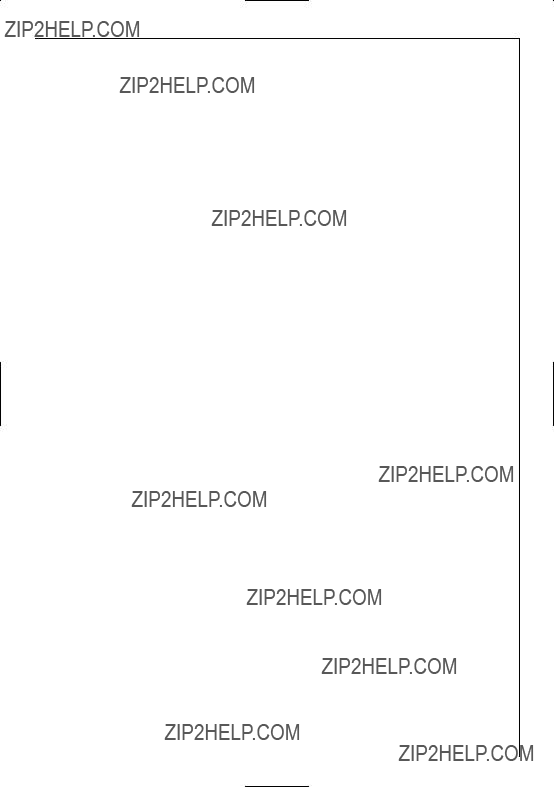
Contents
Something not working? . . . . . . . . . . . . . . . . . . . . . . . . . . . . . . . . . . . . . . . . . . . . . . . . . 38 Troubleshooting . . . . . . . . . . . . . . . . . . . . . . . . . . . . . . . . . . . . . . . . . . . . . . . . . . . . . . . . . . 38 Unsatisfactory washing results . . . . . . . . . . . . . . . . . . . . . . . . . . . . . . . . . . . . . . . . . . . . . 42
Technical data . . . . . . . . . . . . . . . . . . . . . . . . . . . . . . . . . . . . . . . . . . . . . . . . . . . . . . . . . . . 43
Service & Spare Parts . . . . . . . . . . . . . . . . . . . . . . . . . . . . . . . . . . . . . . . . . . . . . . . . . . . . 44
Guarantee Conditions. . . . . . . . . . . . . . . . . . . . . . . . . . . . . . . . . . . . . . . . . . . . . . . . .
Instructions for installation and electrical connection . . . . . . . . . . . . . . . . . . . . . 48 Safety instructions for the installer . . . . . . . . . . . . . . . . . . . . . . . . . . . . . . . . . . . . . . . . . 48
Dimensions of the appliance. . . . . . . . . . . . . . . . . . . . . . . . . . . . . . . . . . . . . . . . . . . . . . 49 Front view and side view . . . . . . . . . . . . . . . . . . . . . . . . . . . . . . . . . . . . . . . . . . . . . . . . . . 49 Rear view . . . . . . . . . . . . . . . . . . . . . . . . . . . . . . . . . . . . . . . . . . . . . . . . . . . . . . . . . . . . . . . . 49
Installation . . . . . . . . . . . . . . . . . . . . . . . . . . . . . . . . . . . . . . . . . . . . . . . . . . . . . . . . . . . . . . 50 Unpacking . . . . . . . . . . . . . . . . . . . . . . . . . . . . . . . . . . . . . . . . . . . . . . . . . . . . . . . . . . . . . . . 50 Positioning . . . . . . . . . . . . . . . . . . . . . . . . . . . . . . . . . . . . . . . . . . . . . . . . . . . . . . . . . . . . . . . 51 Levelling . . . . . . . . . . . . . . . . . . . . . . . . . . . . . . . . . . . . . . . . . . . . . . . . . . . . . . . . . . . . . . . . . 51 Water inlet (cold water connection only). . . . . . . . . . . . . . . . . . . . . . . . . . . . . . . . . . . . 52 Water drainage. . . . . . . . . . . . . . . . . . . . . . . . . . . . . . . . . . . . . . . . . . . . . . . . . . . . . . . .
5
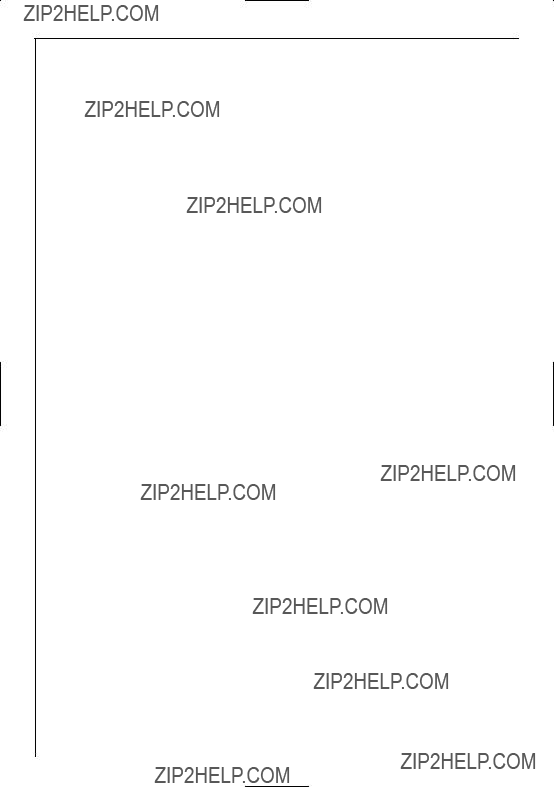
 Safety instructions
Safety instructions
Your safety is of paramount importance, please ensure you read this instruc- tion book before installing or using this appliance.
General safety
???Repairs to the machine must be carried out only by qualified personnel. Repairs carried out by inexperienced persons could cause injury or serious malfunctioning. Contact your local AEG/ELECTROLUX Service Force Centre.
???Never start the machine if the mains cable is damaged or the control pan- el or worktop are damaged allowing inner components to be accessible.
???Unplug the appliance before carrying out any cleaning or maintenance operations.
???Never pull the mains cable to remove the plug from the socket; always take hold of the plug itself.
???During high temperature wash programmes and during the drying cycle, the door glass may get hot.
???Let the water cool down before carrying out emergency emptying or before opening the door in an emergency.
Installation
???Follow the installation instructions carefully.
???Carry out a first wash without laundry (COTTONS 95, with half the amount of detergent) in order to remove any manufacturing residue from the tub and the drum.
6
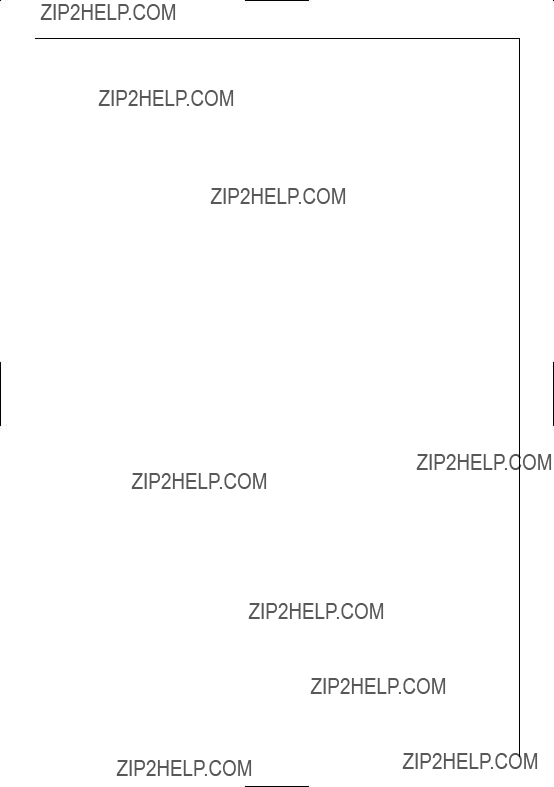
Safety instructions
Child safety
???This appliance is designed to be operated by adults. Children should not be allowed to tamper with the controls or play with the appliance.
???Pets and children have been known to climb into washing machines. Please check the drum before use.
???Keep all packaging well away from children.
???Keep all detergents in a safe place out of children???s reach.
???When disposing of the appliance, cut off the mains cable, and destroy the plug. Disable the door catch to prevent young children being trapped inside.
During use
???Always unplug the appliance and turn off the water tap after use.
???This appliance is designed for domestic use only. If the machine is used for any other purposes or is not used correctly, the manufacturer accepts no responsibility for any possible damage that might occur.
???For safety reasons, the appliance must not be modified.
???Use only detergents suitable for washing machines and follow the manu- facturer???s instructions.
???Garments which have been in contact with flammable solvents should not be machine washed.
???Dyes and bleaching agents may only be used if specifically permitted by the manufacturer of these products. We cannot be held liable for any damage.
7

Disposal
Packaging materials
The materials marked with the symbol  are recyclable. >PE<=polyethylene
are recyclable. >PE<=polyethylene
>PS<=polystyrene >PP<=polypropylene
This means that they can be recycled by disposing of them properly in appro- priate collection containers.
Machine
Use authorised disposal sites for your old appliance. Help to keep your coun- try tidy!
The symbol  on the product or on its packaging indicates that this prod- uct may not be treated as household waste. Instead it shall be handed over to the applicable collection point for the recycling of electrical and electronic equipment. By ensuring this product is disposed of correctly, you will help prevent potential negative consequences for the envi- ronment and human health, which could otherwise be caused by inappropri- ate waste handling of this product. For more detailed information about recycling of this product, please contact your local city office, your household waste disposal service or the shop where you pur- chased the product.
on the product or on its packaging indicates that this prod- uct may not be treated as household waste. Instead it shall be handed over to the applicable collection point for the recycling of electrical and electronic equipment. By ensuring this product is disposed of correctly, you will help prevent potential negative consequences for the envi- ronment and human health, which could otherwise be caused by inappropri- ate waste handling of this product. For more detailed information about recycling of this product, please contact your local city office, your household waste disposal service or the shop where you pur- chased the product.
8

Tips for environmental protection
To save water, energy and to help protect the environment, we recommend that you follow these tips:
???Normally soiled laundry may be washed without prewashing in order to save detergent, water and time (the environment is protected too!).
???Use the energy saving programme when washing normally soiled garments.
???The machine works more economically if it is fully loaded (for both wash- ing and drying cycles).
???When small loads are washed, use only half to two thirds of the recom- mended amount of detergent.
???The machine will consume less energy if the laundry is adequately spun before being dried.
???With adequate
9
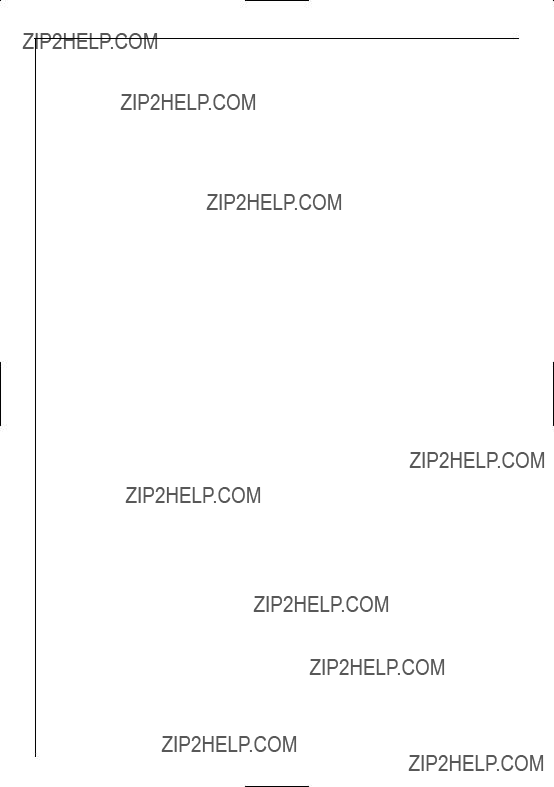
Main features of your
???Programme and temperature setting using the programme selector.
???Stain option for effectively treating stained washing.
???Energy saving programme for normally soiled cotton items.
???SOAK programme for heavy soiled items. The machine performs a soak at 30??C. By pressing the DELAY START button the soak time can be prolonged up to 10 hours max. This programme cannot be used with WOOL pro- gramme. The Soak programme ends with water in the tub. Before selecting the desired washing programme, drain the water setting the drain pro- gramme.
???Speed for the final spin can be reduced to 900, 700 or 500 rpm.
???RINSE HOLD: the laundry is left immersed in the final rinse water to pre- vent creasing.
???DELAY START (delayed start): programme start can be delayed by 30 minutes to 23 hours (e.g. to times with a more economical power rate).
???Programme progress display showing the programme steps selected and the programme phase which is running.
???Because of its gentle washing action, the special wool cycle washes your garments with extreme care.
???The drying programmes will enable you to have dry and soft laundry in a short time.
???
???Unbalance detection device: to prevent vibration during spinning.
10
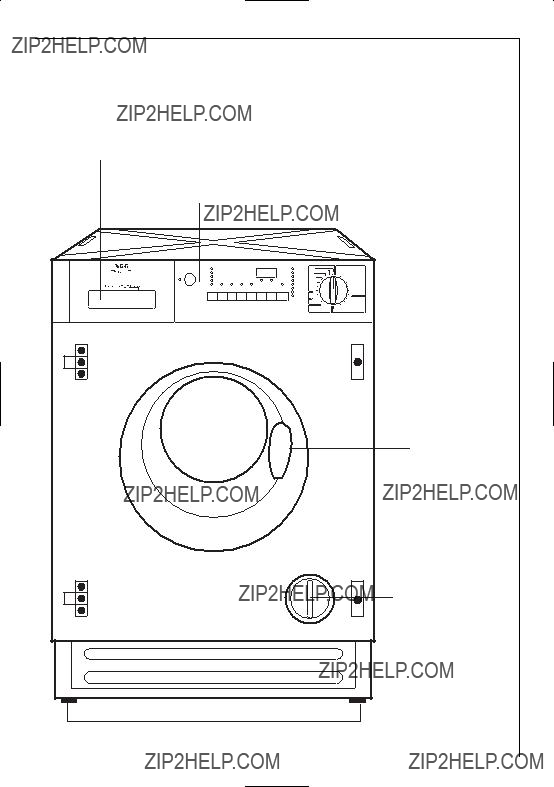
Description of the appliance
Front view
Detergent drawer
Adjustable feet
11

Description of the appliance
Control panel
F
A B C D E G H J
A=
B= ON/OFF button
C= Option buttons
D= Drying time button
E= Delay start button
F= Display
G= START/PAUSE button
H= Programme progress display
J= Programme selector dial
Programme selector dial
The programme selector determines the type of washing cycle (e.g. water level, drum movement, number of rinses, spin speed), the washing temperature and enables the required drying programme to be selected according to the type of laun- dry.
The selector is divided into 5 sections:
L 12710 VIT
???Cotton
???
???Delicates
???Woollens  (hand washing)
(hand washing)
???Special programmes
The selector dial can be turned either clockwise or anticlockwise.
12

Description of the appliance
Position 60E corresponds to the ENERGY SAVING programme for nor- mally soiled laundry, extended washing time. The washing temperature will decrease (cannot be combined with QUICK).
Position DRYING = drying phase;
Position COLD = cold wash.
ON/OFF button
Press this button to switch the machine on. Press it again to switch the machine off.
This light comes on when the ON/OFF button is pressed, and goes out when it is pressed again.
START/PAUSE button
This button has two functions:
a) Start
After having selected the required programme, press this button to start the machine. The relevant pilot light stops flashing and remains static. If you have selected the DELAY START option, the machine starts its hourly countdown.
b) Pause
To interrupt a programme which is running, press the START/PAUSE button: the information on the display remains lit and the START/PAUSE pilot light starts to flash.
To restart the programme from the point at which it was interrupted, press the START/PAUSE button again.
DELAY START button
The wash programme can be delayed from 30, 60, 90 minutes and then 1 hour by 1 hour up to a maximum of 23 hours.
The button must be pressed after selecting the programme and before pressing the START/PAUSE button.
The figures indicating the delay appear for about 3 seconds in the dis- play. The duration of the selected wash programme is then displayed. After depressing the START/PAUSE button, the machine starts its hourly countdown.
13

Description of the appliance
To annul the preset delay, press the START/PAUSE button, then press the DELAY START button until the symbol 0??? is displayed.
Then press the START/PAUSE button again to restart the programme.
DRYING TIME button
If you wish to carry out a timed drying programme push the button until the drying time you want appears in the display according to the fabrics (cotton or easy cares) you have to dry.
For COTTON and EASY CARES you can select a drying time from 10 min- utes to 130 minutes.
In automatic washing and drying programme the drying time is displayed for 3 seconds, then the duration of the programme will appear.
Programme Option buttons
Depending on the programme, different functions can be combined. These must be selected after choosing the desired programme and before depressing the START/PAUSE button.
When these buttons are pressed, the corresponding pilot lights come on. When they are pressed again, the pilot lights go out.
When an incorrect option is selected, the button light flashes for 2 se- conds and in the display the Err message appears.
SPIN SPEED
Press this button to reduce the maximum speed of the final speed proposed by the machine for the selected programme or to select RINSE HOLD option. The maximum spin speed for cotton is 1400 rpm (for L14710VIT), 1200 rpm (for L12710VIT), for easy cares, wool 900 rpm and for delicates and Miniprogramm 700 rpm.
RINSE HOLD
By selecting this option, the last rinse water is not emptied out, to prevent the fabrics from creasing. When the programme has finished, the pilot light END on the programme progress display illuminates and the Door will be locked to indicate that the water must be emptied out.
14
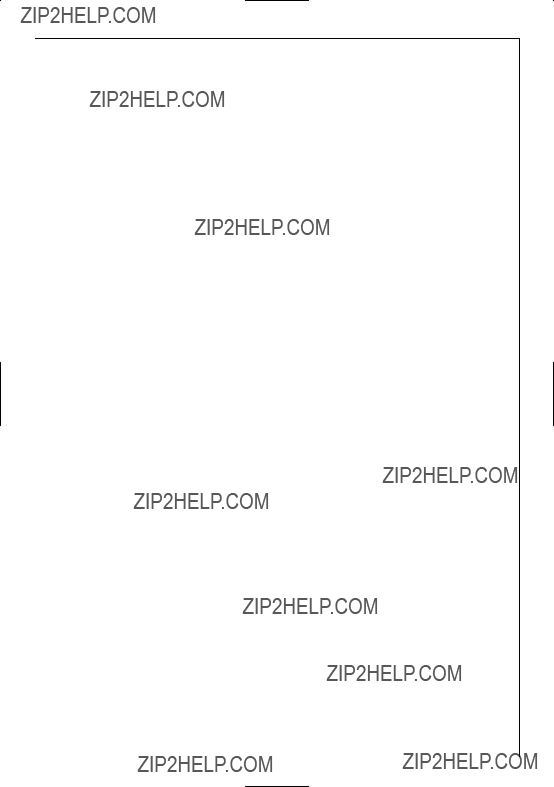
Description of the appliance
To empty out water:
???select the DRAIN programme to empty out the water without spin- ning.
???select the SPIN programme for draining and spinning.
???select the SPIN SPEED and depress the START/PAUSE button;
Warning! The programme selector dial must be turned first to RESET and then to the DRAIN or SPIN programmes.
The RINSE HOLD option cannot be selected for the automatic WASHING & DRYING programme.
PREWASH
The machine performs a prewash cycle at 30??C max. The prewash cycle ends with a short spin in programmes for Cotton and
This option is not available with the wool programme and cannot be used with STAIN.
For use when washing heavily soiled laundry.
STAIN
To treat heavily soiled washing or stained washing with stain remover (extended main wash with time optimised stain action phase, not selectable for wool/handwash or programmes with temperatures lower than 40??C).
This function cannot be used with PREWASH.
QUICK
By pressing this button the washing time is reduced. For use when washing lightly soiled laundry.
This option is not available with the wool/handwash and Economy pro- gramme.
EASY IRON
Selecting this button the laundry is gently washed and spun to avoid any creasing. In this way ironing is easier. Furthermore the machine will perform 6 rinses instead of 3 for cotton and 4 rinses instead of 3 for synthetics. This function can be used only for cotton and
If this option is selected for cotton programmes, the spin speed automaticaly will reduce to 900 rpm.
If this option is selected for synthetic programmes with a temperature of 60??C, the machine will perform a washing cycle at max 40??C.
15

Description of the appliance
Display
The display shows the following information:
???Duration of the selected programme (in hours and minutes), calcu- lated automatically on the basis of the maximum recommended load for each type of fabric.
???Selected drying time (max. 130 minutes for cotton and easy cares).
After the programme has started, the time remaining is updated every minute.
???When the programme has finished, a blinking lit zero is displayed.
???Delayed start, (23 hours max.) programmed using the special button. The countdown is updated every hour and by 30 minutes the last 2 hours.
???Alarm code indicating a fault in the machine operation (see page 38).
Programme progress display
By selecting the wash programme, the pilot lights corre- sponding to the various phases making up the programme come on.
After the machine has started, only the running phase pilot light stays on. When the programme has finished, the END pilot light comes on.
PREWASH
WASH
RINSE
DRAIN
SPIN
DRY
CLEAN
FILTER
END
Cancelling a programme
To cancel a programme which is running, turn the programme selector dial to the RESET position.
Warning! After a programme which ends with water in the drum (RINSE HOLD option), turn the selector dial first to RESET and then to the DRAIN or SPIN programme.
16

Description of the appliance
Altering an option/programme which is running
To alter an option, first set the machine to PAUSE by pressing the START/PAUSE button.
Any option can be modified before the machine starts it. After select- ing the new option press the START/PAUSE button again to
To modify the selected programme turn the programme selector dial to RESET and then choose a new programme.
After pressing the START/PAUSE button again, the machine restarts with the newly selected programme and the water is not emptied out.
Opening the door after the programme has started
You can open the door, after having set the machine to PAUSE, provided the following conditions exist:
???the machine is not in the heating or drying phase beyond 55??C;
???the level of the water is not high;
???the drum is not turning.
If these requirements are met, when you pause the machine the door can be opened.
Should it not be possible to open the door, and should it be absolutely nec- essary to do so, switch the machine off by pressing the ON/OFF button.
After approximately 3 minutes, you can open the door.
Pay attention to the level and temperature of the water in the machine!
When you close the door and press the ON/OFF and START/PAUSE buttons again, the washing machine will resume the programme from the point where it had been interrupted.
17
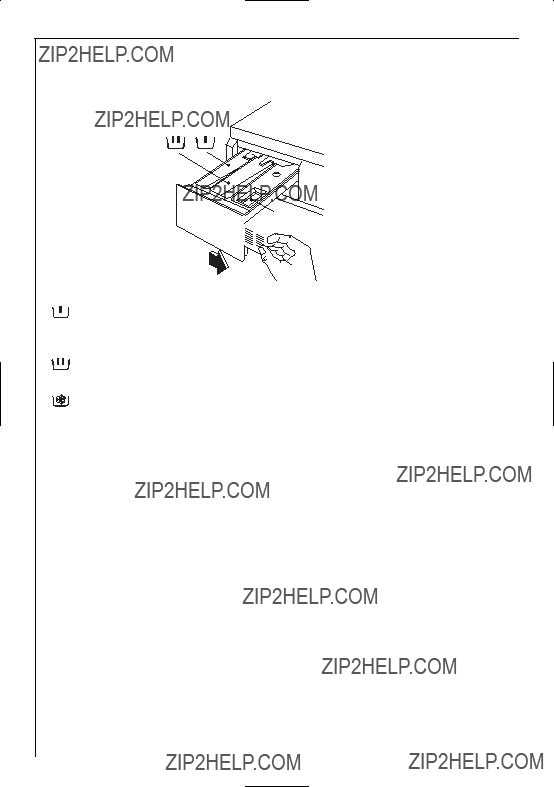
Description of the appliance
Detergent dispenser drawer


 Programme chart
Programme chart
Compartment for prewash or soak detergent and stain remover. The prewash or soak detergent is added at the beginning of the wash programme. The stain remover is added during the
Compartment for powder or liquid detergent used for main wash. It is emptied at the beginning of the wash cycle.
Compartment for liquid additives (fabric softener, starch).
It is emptied at the last rinse.
The quantity of additives must not exceed the ???MAX??? mark in the draw- er.
Before the first wash
Before your first wash, we recommend that you run a cotton cycle at 95??C, without any laundry in the machine, to remove any manufacturing residue from the drum and tub.
Pour 1/2 a measure of detergent into the dispenser drawer and start the machine.
18
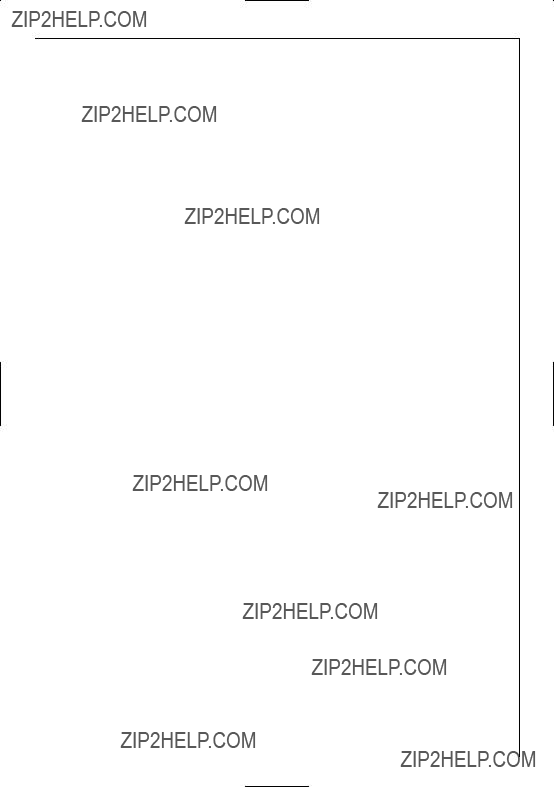
Preparing the wash cycle
Sorting out and preparing the laundry
???Sort out the laundry according to type of fabrics and care labels (see ???Types of fabric and care labels???).
???Empty pockets.
???Remove any metal parts (safety pins, clips, etc.).
???To prevent the laundry from getting damaged and forming bundles, it is advisable to close zips, button up pillowcases and quilt covers and tie up loose straps such as those of aprons.
???Turn double faced items inside out (sleeping bags, anoraks, etc.)
???Turn coloured knitted fabrics, woollens and fabrics with trim inside out.
???Wash small and delicate items (baby socks, tights) inside a laundry net or in a pillow case closed with a zip, or in larger socks.
???Treat curtains with special care. Remove all metal or plastic hooks or put them in a net or a bag. We decline any responsibility in case of damage.
???Whites and coloureds must be washed separately: white items can loose their whiteness.
???New coloured fabrics often have excess dyes; it is advisable to wash them separately for the first time.
???Wash small and large items together; this improves the washing result and the laundry is better distributed during spinning.
???Shake out garments before putting them into the machine.
???Insert each garment separately.
19
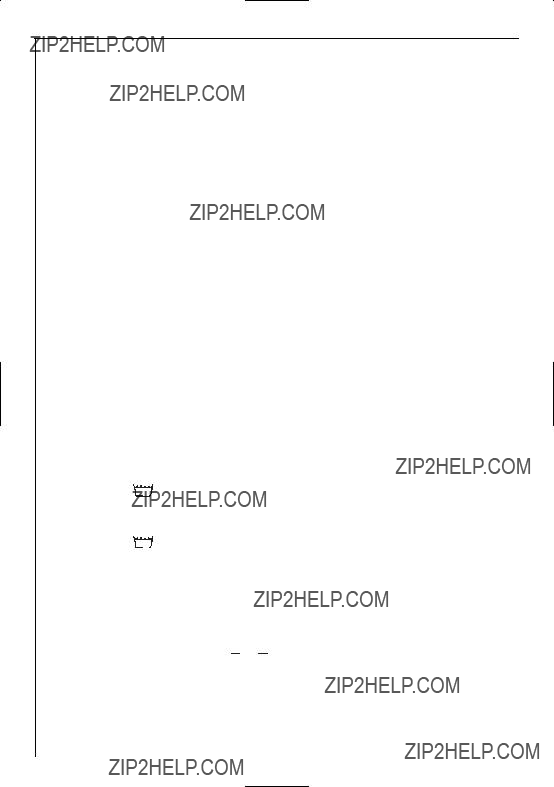
Preparing the wash cycle
Weight of laundry
Types of fabric and care labels
The labels on garments help you to select the most suitable wash programme. The laundry should be sorted out according to the type of fabric and the instructions indicated on care labels.
Temperatures indicated on labels are always maximum temperatures.
Cotton 95
Linen and cottons marked with this symbol can be washed at high tempera- tures.
Cotton 60
Linen and cottons marked with this symbol are colourfast and can be washed at 60??C.
Cotton 

Garments marked with these symbols have delicate colours, therefore the washing temperature must not exceed these values.
Synthetics 

Mixed and synthetic fabrics marked with these symbols require a gentle wash programme and they must therefore be washed using the specific pro- gramme.
20
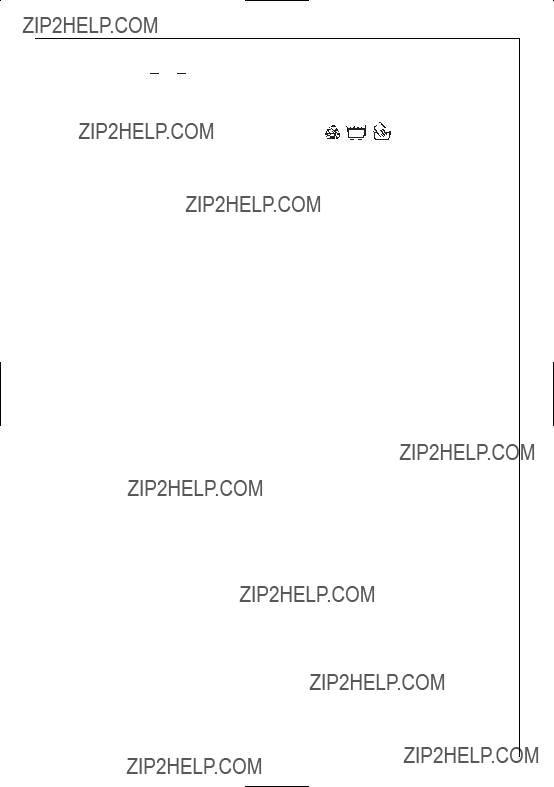
Preparing the wash cycle
Delicates 

Microfibres,
The DELICATES programme is suitable for this type of fabric.
Fabrics such as wool, wool mix or silk marked with this symbol are particu- larly sensitive to machine washing.
The WOOLLENS programme is suitable for this type of fabric.
Fabrics marked with the  symbol (wool) can be machine washed only if the label indicates ???does not felt??? or ???machine washable???.
symbol (wool) can be machine washed only if the label indicates ???does not felt??? or ???machine washable???.
If the label has the symbol  (do not wash), the garments must not be machine washed!
(do not wash), the garments must not be machine washed!
21

Preparing the wash cycle
Detergents and additives
Which detergent?....
To ensure you obtain the best wash results from your appliance, it is impor- tant to use the right detergent in your everyday wash, and only detergents recommended for use in automatic machines.
To maintain the appearance of your clothes and household textiles and to make them last longer you should use different types of detergent for dif- ferent washes, whether for whites, colours or delicates.
WHITES
We recommend the Ariel product range which is bio- logical and designed to provide excellent cleaning and stain removal even at low temperatures.
NON BIOLOGICAL
If you prefer to use a non biological detergent, which does not contain enzymes we recommend Fairy. Fairy provides good cleaning and stain removal.
COLOUREDS
For coloured items you should use a detergent which is designed to clean while maintaining the original colour. Ariel Color does not contain bleach and therefore helps to preserve colours.
DELICATE ITEMS
When washing delicates such as woollens, you should use a product which is specially designed to care for fine fabrics. Dreft Automatic is suitable for woollens and oth- er delicates.
LAUNDRY BLEACH
For additional stain removal you may wish to use a prod- uct such as Ace Gentle Bleach which is used in addition to your chosen detergent. Ace is suitable for all washable fabrics including silks, woollens and coloureds.
STAIN REMOVER
For heavily soiled garments to be washed with STAIN- Action, you should use stain removers such as VANISH In- Wash, Ecover Stain Salt and GloWhite Booster.
NEW
TOUGHERON
STAINS
STAIN REMOVER
FOR WHITES AND COLOURS
JUST ADD TO DETERGENT
22

Preparing the wash cycle
And in which form?
Not only are there different types of detergent, but they are also available in different forms. Whether you chose a powder or liquid in traditional or com- pact form is your own personal choice.
TRADITIONAL POWDERS
Pour the powder directly into the dispenser drawer. Do not sprinkle powder onto clothes in the machine drum.
TRADITIONAL LIQUIDS
Liquid can be placed in the main wash compartment of the detergent draw- er marked with the symbol  , start the machine immediately upon placing the detergent in the dispenser drawer.
, start the machine immediately upon placing the detergent in the dispenser drawer.
Alternatively the detergent is measured into the specially designed dosing device* which should be placed on top of the laundry, and at the back of the machine drum.
COMPACT POWDERS AND LIQUIDS
Compact detergents (or concentrates as they are also known) are available in liquid or powder form, and generally require a smaller dosage. Follow the manufacturer???s instructions to ensure the most economical usage. Pour the detergent directly into the dispenser drawer, or alternatively measure the detergent into the specially designed dosing device* which should be placed on top of the laundry, and at the back of the machine drum.
*If you use a dosing device in a washer dryer, please ensure the dosing device/ball is removed before carrying out a drying programme.
FABRIC CONDITIONERS
These are ideal for improving ???softness???, and also reduce static cling on easy- cares and make ironing easier. They are available in two types:
???For example Lenor liquid fabric softener, for use in the washing machine/washer dryer. The liquid fabric soft- ener should be poured into the compartment marked
with the symbol  . Follow the manufacturer???s dosage instructions and never exceed the MAX level.
. Follow the manufacturer???s dosage instructions and never exceed the MAX level.
???Bounce conditioning sheets for use in a tumble dryer. We recommend the conditioning sheets are pinned (using a safety pin) to an article of laundry and placed in the tum- ble dryer.
23
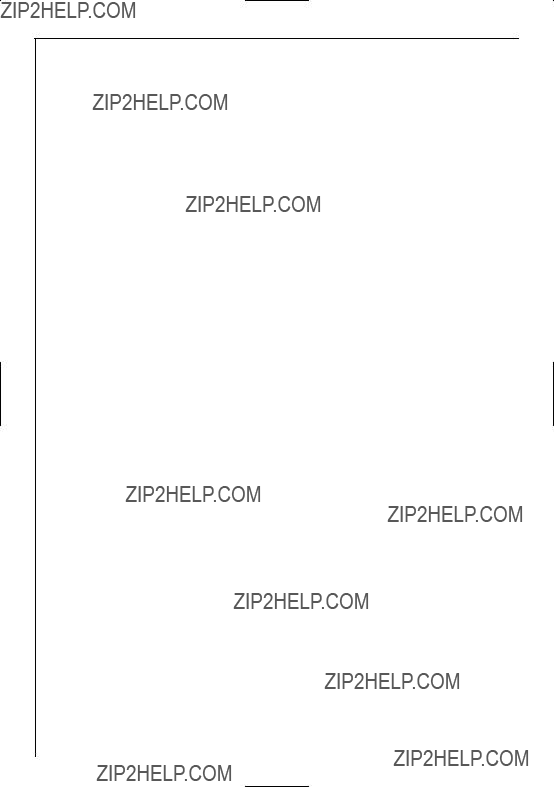
Preparing the drying cycle
As a dryer, the machine works on the condensation principle.
Therefore, the water tap must be open and the drain hose must drain water into a sink or into the drain pipe, even during the drying cycle.
Load
Warning:
Loads of washed laundry exceeding these values must be divided before being dried, otherwise poor results will be obtained.
Garments not suitable for drying
???Particularly delicate items such as synthetic curtains, woollen and silk, gar- ments with metal inserts, nylon stockings, bulky garments such as anoraks, bedcovers, quilts, sleeping bags and duvets must not be machine dried.
???Garments padded with
???Also, fabrics containing residues of setting lotions or hair sprays, nail sol- vents or similar solutions must not be machine dried in order to avoid the formation of harmful vapours.
24

Preparing the drying cycle
Drying symbols on garment labels
Always look at the garment label to check whether garments can be machine dried.
The following symbols refer to drying: Machine drying is usually possible
Normal drying (normal temperature)
Gentle drying (reduced temperature)
Do not machine dry
Duration of the drying cycle
The drying time can vary according to
???the final spin speed;
???the required degree of drying (extra dry, only for cottons, store dry or iron dry);
???the type of laundry;
???the size of load.
The usual drying times are indicated in the programme chart. As you become more familiar with the appliance, you will discover the drying times that best suit your needs according to the various type of fabric. It is a good idea to make a note of these times.
Modification of the drying time
If you wish to modify the drying time when a drying programme is running, first depress START/PAUSE button to set the machine to PAUSE. After modi- fying the time, depress START/PAUSE again to continue the programme.
Fibre residue
After drying fluffy fabrics, such as new towels, it is advisable to perform the rinse cycle to be sure that any residue that may remain in the tub is com- pletely removed and does not stick to garments dried afterwards.
After each drying cycle the filter should be checked and cleaned.
25

Preparing the drying cycle
Additional drying
Should the laundry still be too wet at the end of the programme, set anoth- er short drying cycle.
Warning! To prevent the formation of creases or shrinking of fabrics, avoid excessive drying.
26
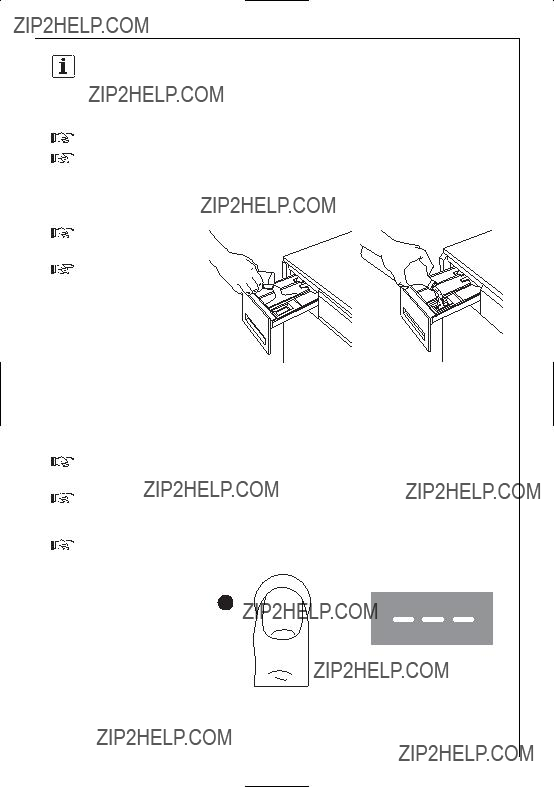
How to wash
Load the laundry
Open the door.
Place the laundry in the drum, one item at a time. Distribute laundry as even- ly as possible. Close the door.
Add detergent and additive
Pull the drawer out till it stops.
Pour the main wash detergent into compartment  .
.
If you wish to per- form a Prewash, SOAK or a STAIN-
Action programme, pour detergent or stain remover into compartment  .
.
Important!
Do not use normal detergent for the
Pour the fabric softener into compartment  without exceeding the ???MAX??? mark.
without exceeding the ???MAX??? mark.
Close the drawer, pushing it fully in.
Switching the machine on
To switch the machine on, press the ON/OFF but- ton: if the pro- gramme selector dial is on the RESET position, three flashing
dashes will be dis- played. If the pro-
gramme selector
dial is left on a wash programme position, at the end of the previous wash- ing cycle, the display will show a flashing zero.
27
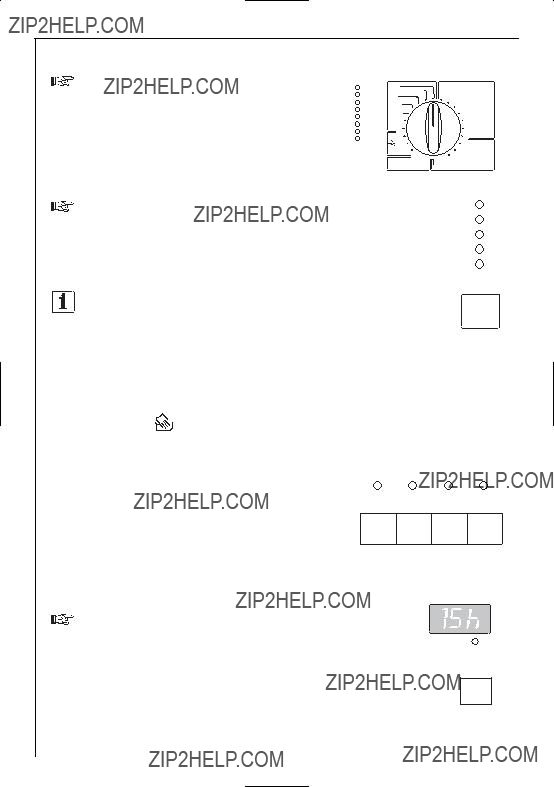
How to wash
Selection of the desired wash programme
Turn the programme selector dial to the desired position: the lights corresponding to the different phases making up the selected programme light up.
Selection of the spin speed or RINSE HOLD option
It is possible to select a lower spin speed by means of the relevant button; the light corresponding to the selected speed comes on.
When selecting the RINSE HOLD option, the laundry is left immersed in the final rinse water.
If the spin speed is not reduced , the final spin speed will be as follows:
1200
900
700
500
RINSE
HOLD
SPIN
SPEED
Selection of the desired option,
depending on the degree of soil of the laundry and
on the type of fabric.
The corresponding light comes on.
Selection of the DELAY START option
To delay starting of a programme, press the DELAY START button before starting the machine. The figures corre- sponding to the selected delay will be displayed for about 3 seconds, after which the duration of the selected pro- gramme will appear on the display.
When the START/PAUSE button is pressed, the selected delay will again appear on the display and the machine starts its countdown.
DELAY
START
28

How to wash
Starting the programme
1.Check that the water tap is open.
2.Press START/PAUSE to start the programme.
If the Delay Start option has been selected the programme will start at the end of the countdown.
At the start of the programme, if the ???END??? light blinks for few sec- onds and on the display appears E40, that indicates that the door is open. Close the door and press the START/PAUSE button again.
If the delay start option has been selected, the machine starts its countdown, in hours, which will appear on the display. During this period it is possible to load other laundry or cancel the delay time.
???Load other laundry: press the START/PAUSE button. Open the door. Load the laundry. Close the door and press the START/PAUSE button again.
???Cancel the delay time: press the START/PAUSE button. Press the DELAY START button until on the display appears 0???, if you wish to cancel it. Press the START/ PAUSE button again to let the pro- gramme restart.
Programme progress display
By selecting the wash programme, the pilot lights correspond- ing to the various phases making up the programme come on. After the machine has started, only the running phase pilot light stays on.
Display
PREWASH
WASH
RINSE
DRAIN
SPIN
DRY
CLEAN
FILTER
END
The time to the end of the programme decreases minute by minute and appears on the display.
29

How to wash
At the end of the programme
The machine stops automatically. A blinking zero appears on the display. The END light comes on in the programme progress display, the START/PAUSE light is off.
Turn the selector dial to RESET.
If the RINSE HOLD option has been selected the END and the RINSE HOLD lights remain lit, the door is blocked, to indicate that the water must be emptied out before opening the door either
To empty out water:
???select the DRAIN programme to empty out the water without spin- ning.
???select the SPIN programme for spinning.
???select the SPIN SPEED and depress the START/PAUSE button;
Warning! The programme selector dial must be turned first to RESET and then to the DRAIN or SPIN programmes.
At the end of the programme the selector dial must be turned to position RESET and the machine must be switched off by pressing the ON/OFF button.
Remove the laundry from the drum.
Check that the drum is empty so as to avoid any forgotten items being damaged in a subsequent wash (e.g. shrinking) or their colour running into a load of whites.
Close the water tap.
Leave the door open to prevent the formation of mildew and unpleas- ant smells.
How to dry
Drying only
Warning! Do not exceed the maximum laundry loads:
-2.5 kg for linen and cottons
-1.5 kg for
The water tap must be open and the drain hose must be positioned in the sink or connected to the drain pipe.
Depress the ON/OFF button to switch the machine on.
Select the drying programme (for cotton or
Depress the DRYING TIME button until the time you want appears in the dis- play.
30

Press the START/PAUSE button to start the programme.
At the end of the cycle, turn the programme selector dial to RESET and press the ON/OFF button again to switch the appliance off.
Remove the laundry.
Automatic washing and drying
Warning! For
Load the laundry.
Add detergent and additive.
Do not use a liquid detergent in a dosing device/ball, because the plastic material of the device will not withstand the high temperature during dry- ing. Pour the liquid detergent directly into the main wash compartment.
Switch the machine on by depressing the ON/OFF button.
Select the wash programme.
Select the required options by means of the relevant buttons. If possible, do not select a spin speed lower than that proposed by the appliance to avoid a too long drying time so saving energy.
When automatically washing and drying it is not possible to select a spin speed lower than 900 r.p.m. for cottons and 700 r.p.m. for synthetics.
Select the drying time.
Start the programme by depressing the START/PAUSE button.
At the end of the programme, turn the selector dial to RESET and press the ON/OFF button again to switch the machine off.
Remove the laundry.
31

Programme chart
Wash programmes
In compliance with EC directive 92/75, the consumption figures indicated on the energy label refer to the ???60E??? wash programme for cotton.
*The consumption data shown on this chart is to be used as a guide only, as it may vary depending on the quantity and type of laundry, on the inlet water tem- perature and on the ambient temperature. It refers to the highest temperature for each wash programme.
**Not with the positions 30??.
32

Programme chart
Special programmes
Heavy soiled Soak fabrics
Soak at 30??C for about 20 minutes.
Stop with water in the
Rinses
except wool.
This pro- gramme can be used for rinsing hand washed cot- ton garments.
Hand washed
tub (Rinse Hold).
3 rinses with liquid additive.
Long spin.
1 rinse with liquid
Softeners
garments to be starched or softened.
For emptying out the last rinse water in programmes
additive. Long spin.
The water is emptied
Drain with the Rinse Hold option  or at the end of pro- gramme Soak.
or at the end of pro- gramme Soak.
out.
* The consumption data shown on this chart is to be used as a guide only, as it may vary depending on the quantity and type of laundry, on the inlet water tem- perature and on the ambient temperature. It refers to the highest temperature for each wash programme.
33
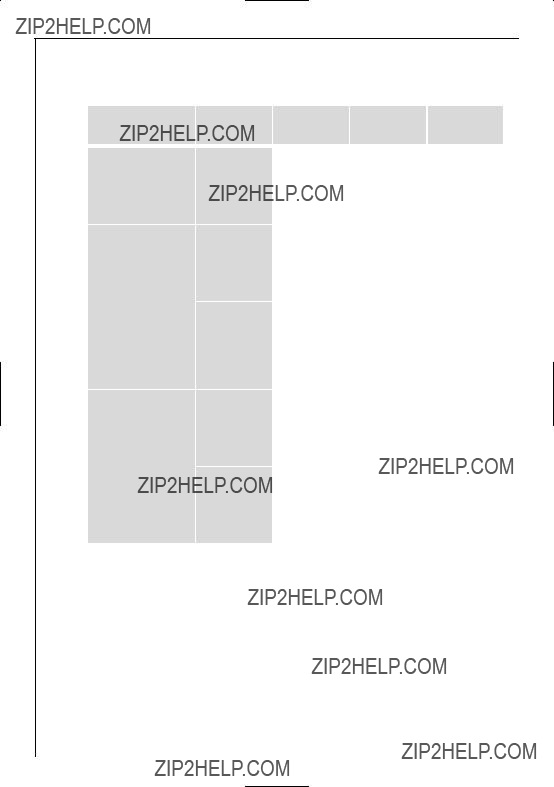
Programme chart
Drying
Degree of drying Type of fabric
Extra dry
Ideal for towelling materials
Store dry (*) Suitable for items to put away without ironing
Iron dry
Suitable for ironing
Cotton and linen (bathrobes, bath towels, etc.)
Cotton and linen (towels,
Cotton and linen (sheets, tablecloths, shirts, etc.)
(*) The STORE DRY drying programme for cotton is the reference programme for the Energy Label data, in compliance with standard EEC 92/75.
34

Cleaning and maintenance
After each wash
At the end of the wash programme, pull the dispenser drawer out a little to let it dry.
Leave the door ajar to allow air to circulate.
If the machine is not used for a prolonged period:
Close the water tap and unplug the appliance.
Periodical cleaning
Maintenance Wash
With the use of low temperature washes it is possible to get a build up of residues inside the drum.
We recommend that a maintenance wash be performed on a regular basis.
To run a maintenance wash:
The drum should be empty of laundry.
Select the hottest cotton wash programme.
Use a normal measure of detergent, must be a powder (such as Ariel Futur).
Exterior
Clean the outside of the cabinet with soap and water only. Rinse with clean water and dry.
Important: do not use methylated spirits, solvents or similar products to clean the cabinet.
Detergent dispenser drawer
After a while, detergents and fabric softeners leave deposits in the drawer.
Clean the drawer, from time to time, by rinsing it under a running tap.
35

Cleaning and maintenance
To remove the drawer from the machine, press the button in the rear left- hand corner.
To facilitate cleaning, the top part of the additive compartment can be removed.
Detergent can also accumulate inside the draw- er recess: clean it with an old toothbrush.
Refit the drawer after cleaning.
Door seal
Regularly check to see, if there are deposits or foreign objects in the rubber seal behind the door and remove them.
Drain filter
The drain filter collects threads and small objects inadver-
tently left in the laundry. Check regularly that the filter is clean.
Place a container under the filter and unscrew it; some water will come out of the filter.
Pull out the filter.
Clean the filter under a running tap, then refit it, screwing it fully in.
36
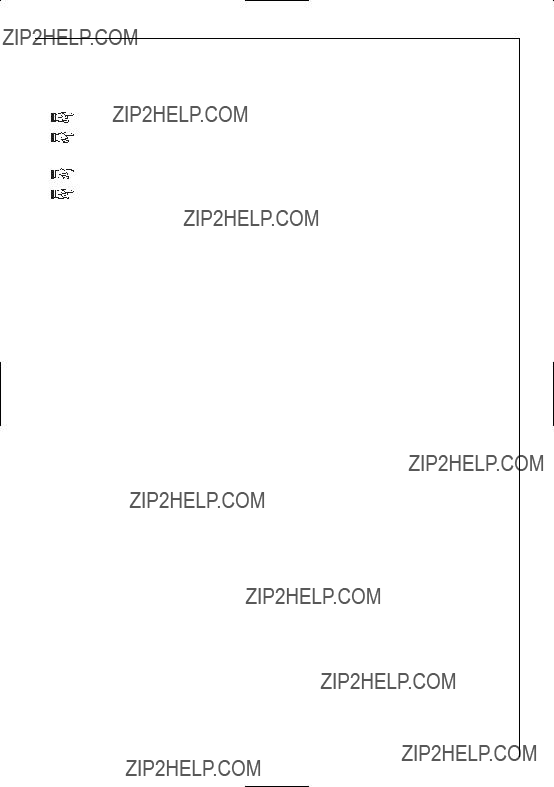
Cleaning and maintenance
Water inlet filter
If you notice that the machine is taking longer to fill, check that the filter in the water inlet hose is not blocked.
Turn off the water tap.
Unscrew the hose from the tap. To do this, depress the small yellow button on the hose.
Clean the filter with a stiff brush.
Screw the hose back onto the tap.
Emergency emptying out
If the water is not discharged (pump is blocked, filter or drain hose are clogged), proceed as follows to empty out the machine:
???pull out the plug from the power socket;
???close the water tap;
???if necessary, wait until the water has cooled;
???place a bowl on the floor;
???put the drain hose end into the bowl and let the water out.
Should it not be possible to have access to the drain hose because, for exam- ple the appliance is built in the kitchen furniture, slightly loosen the drain fil- ter after placing a bowl on the floor to let the water come out slowly.
At the end screw the filter again.
Frost precautions
If the machine is installed in a place where the temperature could drop below 0??C, proceed as follows:
???Close the water tap and unscrew the water inlet hose from the tap.
???Place the end of the drain hose and the inlet hose in a bowl placed on the floor.
???Select the ???DRAIN??? programme and run it until the machine stops.
???Turn the programme selector dial to RESET.
???Press the ON/OFF button to switch the machine off.
???Remove the plug from the power socket.
???Screw the water inlet hose back on and put the drain hose back in its place.
By doing this, any water remaining in the machine is removed, avoiding the formation of ice and, consequently, damage to the appliance.
When you use the machine again, make sure that the ambient temperature is above 0??C.
37

Something not working?
If, during the spin cycle, the machine makes an unusual whistling noise, different from the noise made by traditional washing machines, this is due to a new type of motor.
If water is not visible in the drum, this is due to the modern technology of new washing machines that use less water than traditional machines.
Troubleshooting
If a problem arises, you can try to solve it yourself following the instructions below.
If you call out an engineer when one of the following problems arises, or to repair a fault due to incorrect use, the
During machine operation the following alarm codes may be displayed:
-E10: problem with the water supply
-E20: problem with water draining
-E40: door open
At the same time the light END flashes.
Once the problem has been eliminated, press the START/PAUSE button to restart the programme. If after all checks, the problem persists, contact your local AEG/ELECTROLUX Service Force Centre.
38

Something not working?
Problem
The machine does not fill
The machine fills then empties immediately
The machine does not empty and/or does not spin
There is water on the floor
39

Something not working?
40

Something not working?
Spinning starts late or the machine does not spin
The machine will not dry or the laundry is not dry enough
41

Something not working?
Unsatisfactory washing results
If the laundry looks grey and lime scale is found in the drum
???Too little detergent has been used.
???An unsuitable detergent has been used.
???Stubborn stains have not been treated prior to washing.
???The programme/temperature has not been correctly selected.
If grey stains remain on the laundry
???Laundry stained with ointments, grease or oil has been washed with an insufficient amount of detergent.
???The temperature selected for the wash programme was too low.
???Fabric softener - especially the concentrated type - has come into direct contact with the laundry. Wash these stains immediately and pour fabric softener carefully.
Foam is still visible even after the last rinse
???Modern detergents often produce foam, even in the last rinse. However the laundry has been completely rinsed.
White residue is left on the laundry
???This is due to insoluble components in modern detergents and is therefore not the result of insufficient rinsing. Shake or brush the laundry. In future, it may be better to turn garments inside out before washing them. Check the choice of detergent; try using liquid detergents.
42

Technical data
This appliance complies with the following EC directives:
- 73/23/EEC of 19.2.1973 ???Low voltage directive???, including directive 93 / 68 / EEC
-89/336/EEC of 3.5.1989 ???Electromagnetic Compatibility Directive???.
43
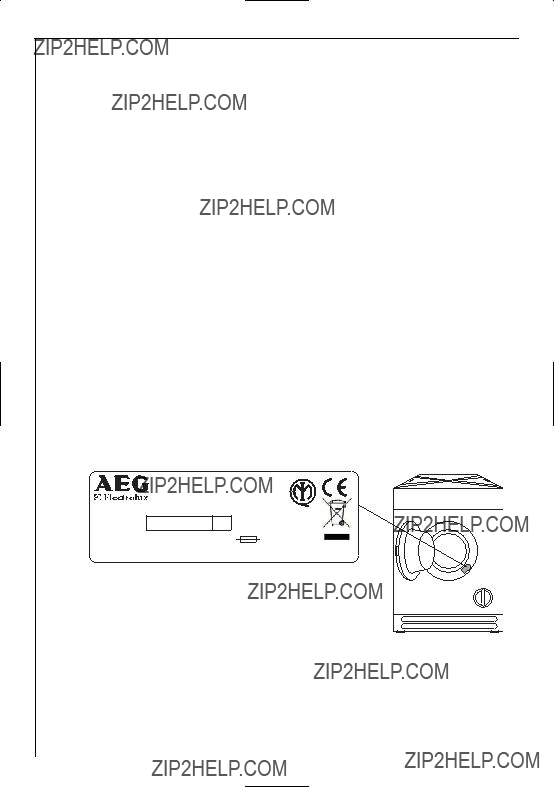
Service & Spare Parts
If after carrying out the necessary checks there is still a fault with your appliance please contact your local AEG/ELECTROLUX Service Force Centre.
In guarantee customers should ensure that the suggested checks in the ???Troubleshooting??? section have been made as the engineer will make a charge if the fault is not a mechanical or electrical breakdown.
Please note that proof of purchase is required for
Service & Spare Parts
If you require a service engineer or wish to purchase spare parts, contact your local AEG/ELECTROLUX Service Force Centre, by telephoning:
08705 929 929
Help us to help you
Please determine your type of enquiry before telephoning. When you con- tact us we need to know:
1.Your name, address and post code.
2.Your telephone number.
3.Clear and concise details of the fault.
-What is the fault?
-When does the fault occur?
-Does the
4.The model, production number and production identification number.
5.Date of purchase.
Mod. L12710VIT Type P6497489
This information can be found on the rating plate, so you have these num- bers to hand we recommed you write them below.
Prod. No. . . . . . . . . . . . . . . . . . . . . . . . . . .
Ser. No. . . . . . . . . . . . . . . . . . . . . . . . . . . .
44

Service & Spare Parts
Customer care
For general enquiries regarding your AEG/ELECTROLUX appliance, or further
information on AEG/ELECTROLUX products please contact our Customer Care Department at the address below or visit our website at
Customer Care Department AEG/ELECTROLUX Major Appliances Addington Way
Luton
Bedfordshire LU4 9QQ
Tel: 08705 350350*
*Calls to this number may be recorded for training purposes.
45

Guarantee Conditions
AEG/ELECTROLUX offer the following guarantee to the first purchaser of this appliance.
1.The guarantee is valid for 12 months commencing when the appliance is handed over to the first retail purchaser, which must be verified by pur- chase invoice or similar documentation.
The guarantee does not cover commercial use.
2.The guarantee covers all parts or components which fail due to faulty workmanship or faulty materials. The guarantee does not cover appliances where defects or poor performance are due to misuse, accidental damage, neglect, faulty installation, unauthorised modification or attempted repair, commercial use or failure to observe requirements and recommendations set out in the instruction book.
This guarantee does not cover such parts as light bulbs, removable glass- ware or plastic, dust bags or filters.
3.Should guarantee repairs be necessary the purchaser must inform the near- est customer service office (AEG/ELECTROLUX???s service or authorised agent). AEG/ELECTROLUX reserves the right to stipulate the place of the repair (i. e. the customer???s home, place of installation or AEG/ELECTROLUX workshop).
4.The guarantee or free replacement includes both labour and materials.
5.Repairs carried out under guarantee do not extend the guarantee period for the appliance. Parts removed during guarantee repairs become the property of AEG/ELECTROLUX.
6.The purchaser???s statutory rights are not affected by this guarantee.
46

Guarantee Conditions
European Guarantee
If you should move to another country within Europe then your guarantee moves with you to your new home subject to the following qualifications:
-The guarantee starts from the date you first purchased your product.
-The guarantee is for the same period and to the same extent for labour and parts as exist in the new country of use for this brand or range of products.
-This guarantee relates to you and cannot be transferred to another user.
-Your new home is within the European Community (EC) or European Free Trade Area.
-The product is installed and used in accordance with our instructions and is only used domestically, i.e. a normal household.
-The product is installed taking into account regulations in your new country.
Before you move please contact your nearest Customer Care Centre, listed below, to give them details of your new home. They will then ensure that the local Service Organisation is aware of your move and able to look after you and your appliance.
47

Instructions for installation and electrical con- nection
Safety instructions for the installer
???This appliance is heavy, care should be taken when moving it.
???When unpacking the appliance, check that it is not damaged. If in doubt, do not use it and contact the retailer.
???All internal packing must be removed before using the appliance. Serious damage may be caused to the machine or adjacent furniture if the protec- tive transit devices are not removed or are not completely removed. Refer to the relevant paragraph.
???Any electrical work required to install this appliance must be carried out by a qualified electrician or competent person.
???Any plumbing work required to install this appliance must be carried out by a qualified plumber or competent person.
???After having installed the machine, check that it is not standing on its elec- trical supply cable.
???If the appliance is placed on a carpeted floor, ensure that air can circulate freely between the adjustable feet and the floor.
???The installation should comply with local water authority and building reg- ulations requirements.
???Should the appliance power supply cable need to be replaced, this should be carried out by our Service Force Centre.
48

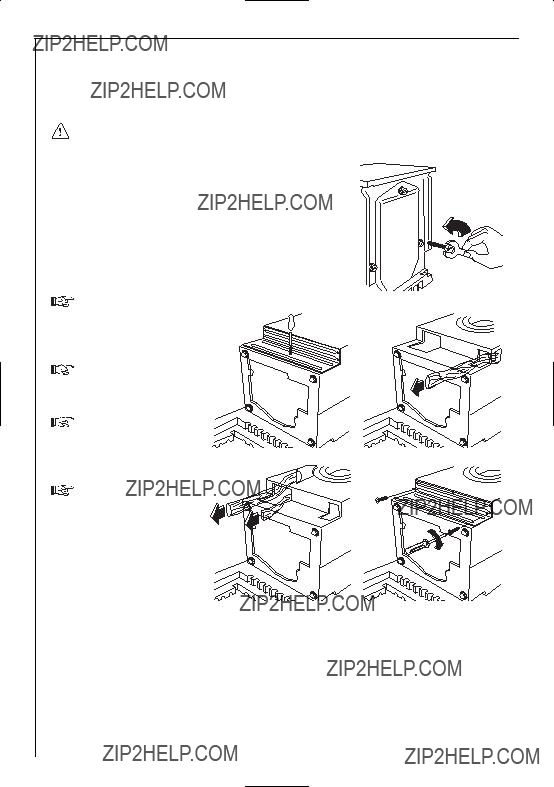
Installation
Unpacking
All transit bolts and packing must be removed before using the appliance.
 Using the supplied spanner, unscrew and remove the rear
Using the supplied spanner, unscrew and remove the rear
P025
Remove the polystyrene base and take off the bottom panel by 
 unscrewing the
unscrewing the 

central screw.
Carefully slide out the right poly- thene bag.
Repeat the opera- tion for the left and central poly- thene bags.
50

Installation
Set the machine
upright and remove
the two remaining bolts from the back.
Pull out the three
plastic spacers from
the holes into which the bolts were fit-
ted.
Plug the open holes with the plugs which you will find in the plastic bag containing the instruction booklet.
You are advised to keep all transit devices so that they can be refitted if the machine ever has to be transported again.
Positioning
Install the machine on a flat hard floor.
Make sure that air circulation around the machine is not impeded by carpets, rugs etc.
???Before placing it on small tiles, apply a rubber coating.
???Never try to correct any unevenness in the floor by putting pieces of wood, cardboard or similar materials under the machine.
???If it is impossible to avoid positioning the machine next to a gas cooker or
???The machine must not be installed in rooms where the temperature can drop below 0??C.
???The water inlet hose and the drain hose must not be kinked.
???Please ensure that when the appliance is installed, it is easily accessible for the engineer in the event of a breakdown.
Levelling
Carefully level by screwing the adjustable feet in or out. Never place cardboard, wood or sim- ilar materials under the machine to compen- sate for any unevenness in the floor.
51
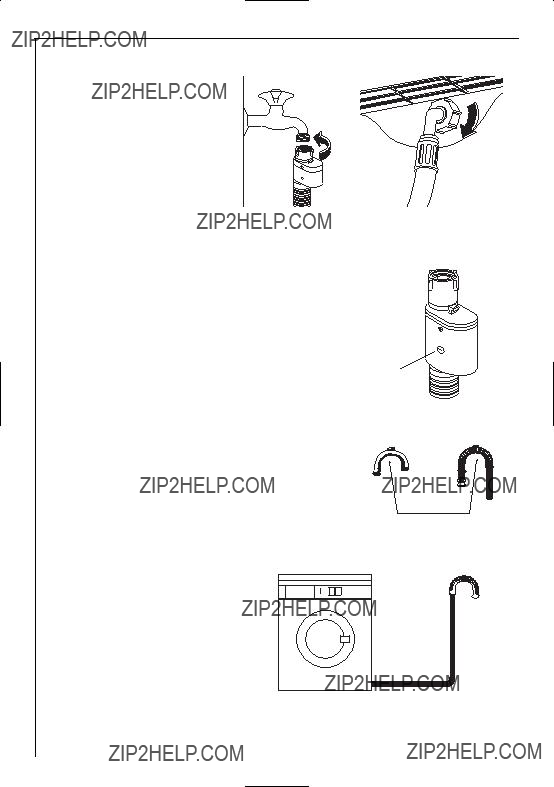
Installation
Water inlet (cold water connection only)
Connect the hose to a tap with a 3/4??? thread.
Installation should comply with local water authority and
building regulations??? requirements.
Set the hose correctly by loosening the ring
nut. After positioning the inlet hose, be sure to tighten the ring nut again to prevent leaks.
Do not connect to a hot water supply.
The inlet hose is provided with a water stop device, which protects against damage caused by water leaks in the hose which could develop due to nat- ural ageing of the hose. This fault is shown by a red sector in the window ???A???. Should this occur, turn
the water tap off and refer to your Service Force A Centre to replace the hose.
Water drainage
TThis appliance is designed to be perma- nently plumbed into your home's drainage system using one of the following methods.
1. Into a drainage standpipe.
Firstly form a hook in the end of the drain hose using the ???U??? piece??? supplied.
Place the drain hose into your standpipe, which should have an internal diameter of approx- imately 38mm thus ensuring there is an air break between the drain hose and standpipe.
P1074
???U??? piece supplied
P1199
38 mm (11.2???) standpipe diameter

 30 cm (12")
30 cm (12")
52
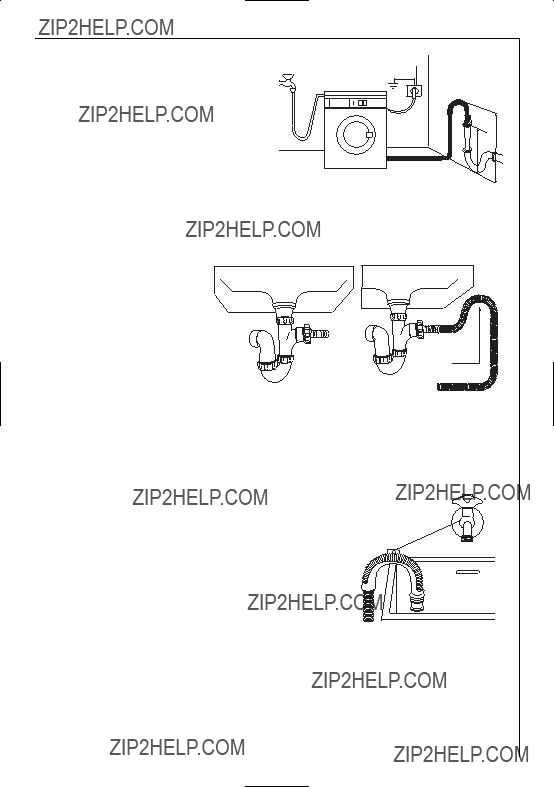
53

Installation
In the interest of the environment
Washing machines and dish- washers should be connected to the FOUL drainage system, the water will then be taken to a sewage works for treat- ment before being discharged safely into a river.
SHOWER
It is essential that these appli- ances are not connected to the surface water drainage system as this water is discharged directly into a river or stream and may cause pollution.
If you require any further advice please contact your local water authority.
Electrical connections
WARNING: THIS APPLIANCE MUST BE EARTHED.
The manufacturer declines any liability should this safety measure not be observed.
If the plug that is fitted to your appliance is not suitable for your socket outlet, it must be cut off and the appropriate plug fitted.
Remove the fuse from the cut off plug.
GREEN &YELLOW 13AMP FUSE
13 AMP
The cut off plug should then be disposed of to prevent the hazard of shocks in case it should be plugged into a 13 Amp socket in another
BLUE
BROWN
part of your home.
Important
CORD CLAMP
The wires in the mains lead are coloured in accordance with the following code:
54
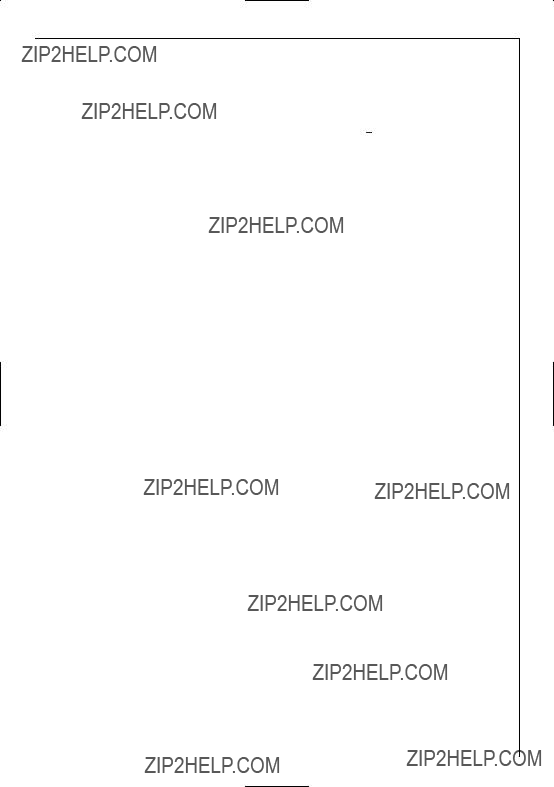
If you fit your own plug, the colours of the wires in the mains lead of your appliance may not correspond with the markings identifying the terminals in your plug, proceed as follows:
Connect the green and yellow (earth) wire to the terminal in the plug which is marked with the letter ??E?? or the earth symbol  or coloured green and yellow.
or coloured green and yellow.
Connect the blue (neutral) wire to the terminal in the plug which is marked with the letter ??N?? or coloured black.
Connect the brown (live) wire to the terminal in the plug which is marked with the letter ??L?? or coloured red.
The plug moulded on to the lead incorporates a fuse. For replacement, use a 13 Amp BS1362 fuse. Only ASTA or BSI approved fuses should be used.
The plug must not be used if the fuse cover/carrier is lost. The cover/carrier is indicated by the coloured insert at the base of the plug.
A replacement cover/carrier must be obtained from your local AEG/ELEC- TROLUX Service Centre.
Permanent connection
In the case of a permanent connection it is necessary that you install a dou- ble pole switch between the appliance and the electricity supply (mains), with a minimum gap of 3 mm between the switch contacts and of a type suitable for the required load in compliance with the current electrical regulations.
The switch must not break the yellow and green earth cable at any point. This operation should only be performed by a qualified electrician.
55

This appliance has been designed to be built into the kitchen furniture. The recess should have the dimen- sions shown in picture A.
When installing the appli- ance into the kitchen furni- ture ensure, if possible, the hoses are placed in either of the two recesses on the back of the appliance. This will help to prevent the hoses from becoming kinked or trapped. Picture AB.
A
820 min
195
Preparation and assembly of the door
The height
56
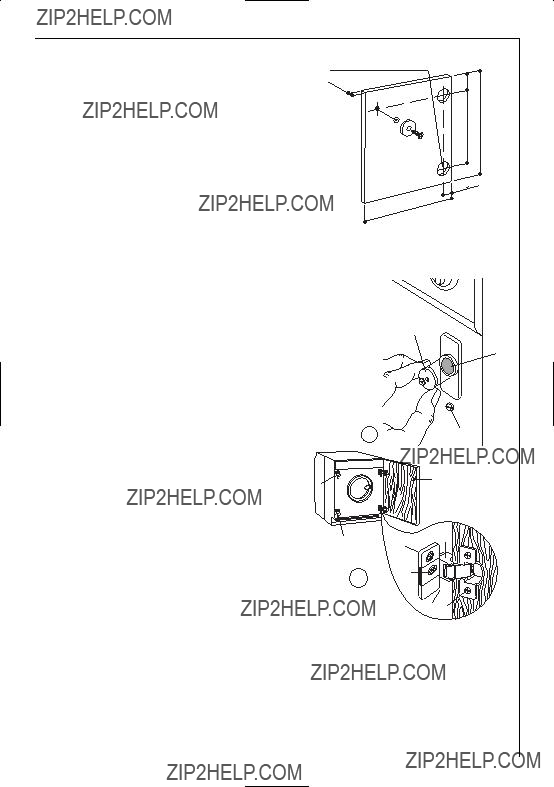
b) Hinges
To mount the hinges it is necessary to drill two holes (dia. 35 mm, depth
The distance (B) from upper edge of the door to the centre of the hole depends on the adjacent furniture's dimensions.
35 ??
The required dimensions are given in the picture C.
The hinges will be fixed to the door by means of screws for wood
c) Mounting the door
Fix the hinges (1) to the machine by means of the M5x15 screws
To align the door perfectly it is necessary to loosen the screw
d)
the door.
Its position must correspond to the magnet (4) on the appliance (see picture D).
6
4
6
71
E 3
 8
8  2
2
If the door has to be opened from left to right, invert the position of the plates (7), the magnet (4) and the plate (5) (Fig. B and E). Mount the coun- termagnet (6) and the hinges (1) as previously described.
Important: the plastic screw (8) should never be loosened (Fig. B and E).
57
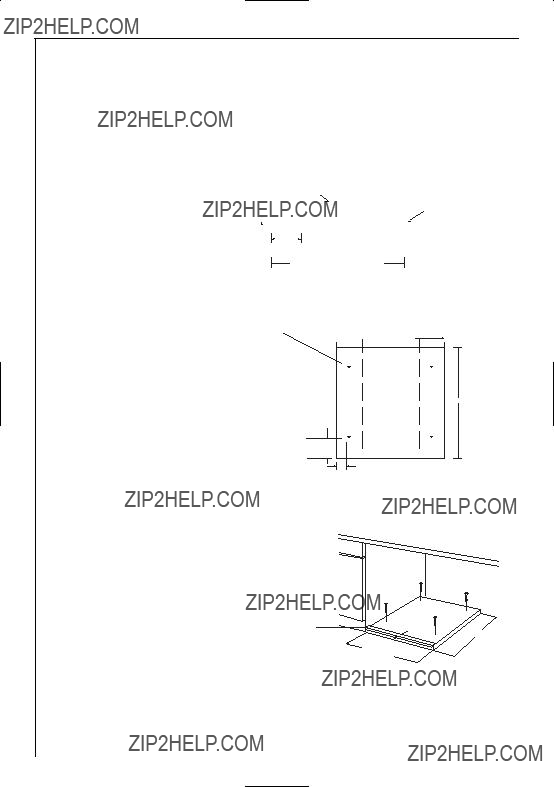
Recommendations regarding the construction and fitting of a base when the installation requires an integrated appliance to be raised
Where the appliance has been raised by mounting onto a wooden base pro- vided by the installer. The material used to construct the base should have a non slip surface, be water repellent and if possible be one solid piece.
If it is not possible to use one solid piece, due to the additional height required, ensure that any additional strips of timber are glued and screwed to the under- side of the base (see Fig. F).
100 mm
Front
Fview
Drill four fixing holes see Fig. G
Position the base into the recess with its front edge as far forward as the adjoining plinth line will allow. The reason for placing the base in this position is to allow a small strip of bead- ing to be fitted in front of the appliance feet.

490 mm
95 mm
Front edge
50 mm
Top
Gview
Fix the base firmly to the floor using four appropriate countersunk screws
(see Fig. H).
Hardwood strip 5 mm x 25 mm
5 X 25 X 605
490
H
58

With the appliance installed adjust all four feet ensuring the machine is stable, and a clearance of approximately 5 mm is left between the top of the machine and the underside of the worktop.
A final check for stability should be carried out with the machine on spin with a load, this will identify the need for any further fine adjustment to the feet.
A strip of beading approximately 605 mm W, x 5 mm H, x 25 mm D must be screwed down into the base directly in front of the machine???s feet, this will provide additional security.
If required an additional door magnet, part number
59

AEG Hausger??te GmbH
Postfach 1036
http://www.aeg.hausgeraete.de
?? Copyright by AEG
 From the Electrolux Group. The world???s No. 1 choice.
From the Electrolux Group. The world???s No. 1 choice.
The Electrolux Group is the world's largest producer of powered appliances for kitchen, cleaning and outdoor use. More than 55 million Electrolux Group products (such as refrigerators, cookers, washing machines, vacuum cleaners, chain saws and lawn mowers) are sold each year to a value of approx. USD 14 billion in more than 150 countries around the world.